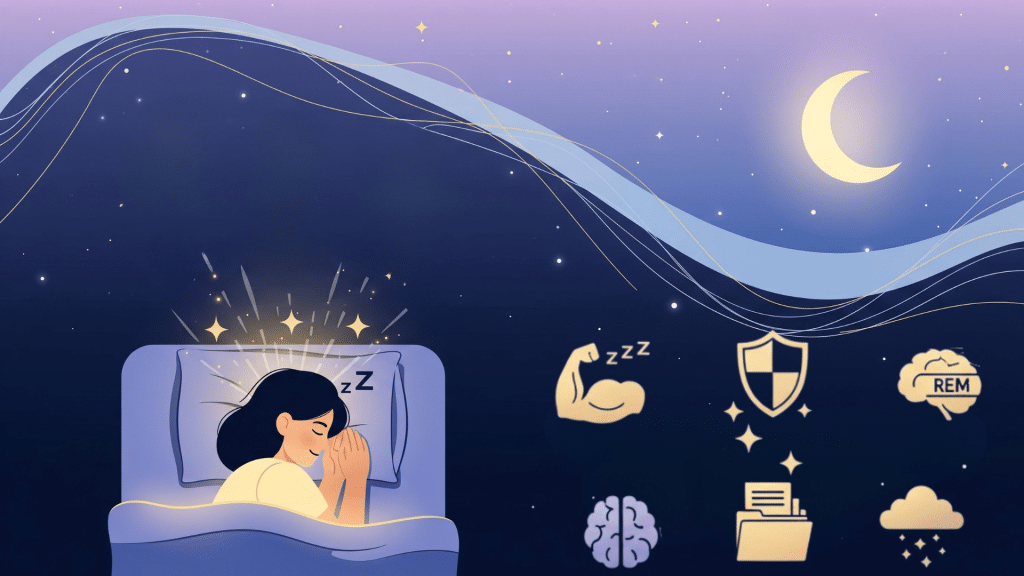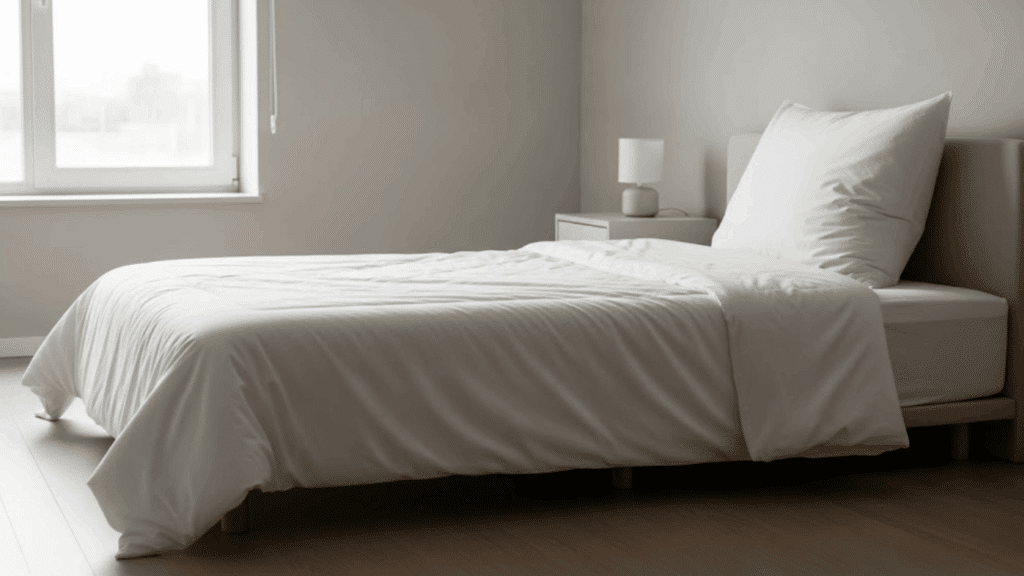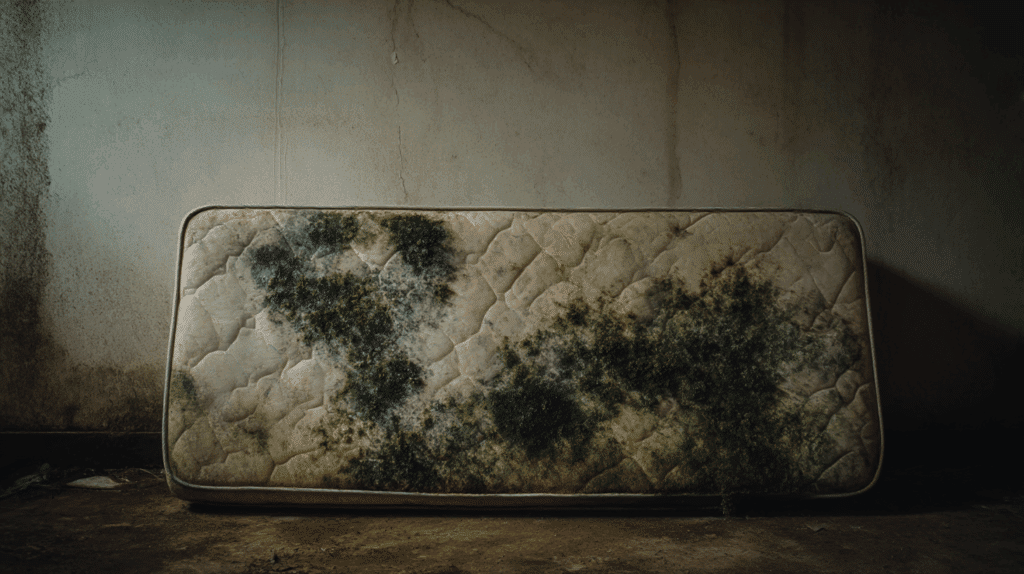Sleep quality affects every part of your health, from your mood and memory to your immune system and energy levels.
Getting enough sleep hours doesn’t guarantee you’ll feel rested if the quality isn’t right. Understanding what makes sleep truly restorative can change how you approach your nightly rest.
Core sleep has become a popular term thanks to wearable devices like Apple Watch, Fitbit, and Whoop that track different sleep stages.
This type of sleep represents the most important part of your nightly rest cycle.
Knowing what core sleep is and how to get more of it can help you wake up feeling truly refreshed instead of tired despite spending enough time in bed.
What Is Core Sleep?
Core sleep combines your two most restorative sleep stages: deep sleep (also called Slow Wave Sleep) and REM sleep.
These stages work together to repair your body, process memories, and prepare you for the next day.
During core sleep, your body does its most important repair work. Deep sleep helps your muscles recover and your immune system strengthen.
REM sleep processes emotions and memories from the day while supporting brain health.
Core sleep stages form the foundation for feeling refreshed and restored each morning. You can spend 8 hours in bed, but still feel tired if you don’t get enough core sleep during those hours.
The Science Behind Core Sleep
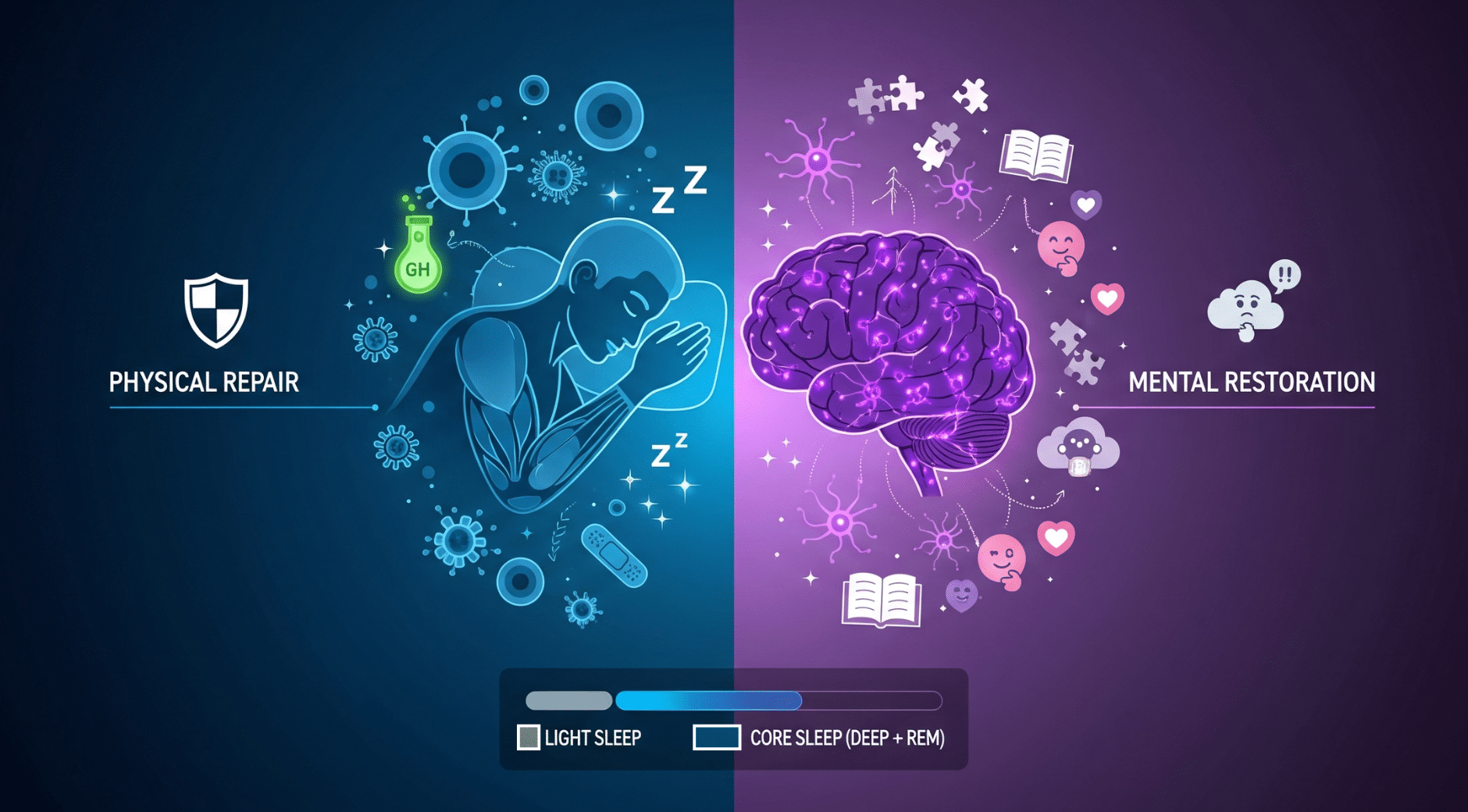
Deep sleep and REM sleep each serve specific functions that regular light sleep cannot provide.
During deep sleep, your body releases growth hormone, repairs tissues, and strengthens your immune system.
REM sleep handles memory processing, emotional regulation, and brain development. This stage helps you learn new information, solve problems, and manage stress from daily life.
Your brain activity during REM sleep is almost as high as when you’re awake.
Core sleep quality matters more than total sleep time for feeling rested. Someone who gets 6 hours with plenty of deep and REM sleep often feels better than someone who gets 8 hours of mostly light sleep.
How is Core Sleep Measured?
Modern wearable devices track core sleep by monitoring your heart rate, movement, and sometimes breathing patterns throughout the night.
Apple Watch, Fitbit, Whoop, and similar devices use these signals to estimate when you’re in different sleep stages. The technology has improved significantly in recent years.
These devices detect sleep stages by looking for specific patterns. Deep sleep shows very low movement and a slow, steady heart rate.
REM sleep features rapid eye movements (hence the name), increased brain activity, and temporary muscle paralysis. Light sleep falls between these two states.
Your sleep data reports show “core sleep hours” as the combined time spent in deep and REM stages.
Most adults should aim for 3-5 hours of core sleep per night, though individual needs vary. Consistently getting less than 20% of your total sleep as core sleep may indicate sleep quality issues.
Core Sleep vs. Other Sleep Stages: What’s the Difference?
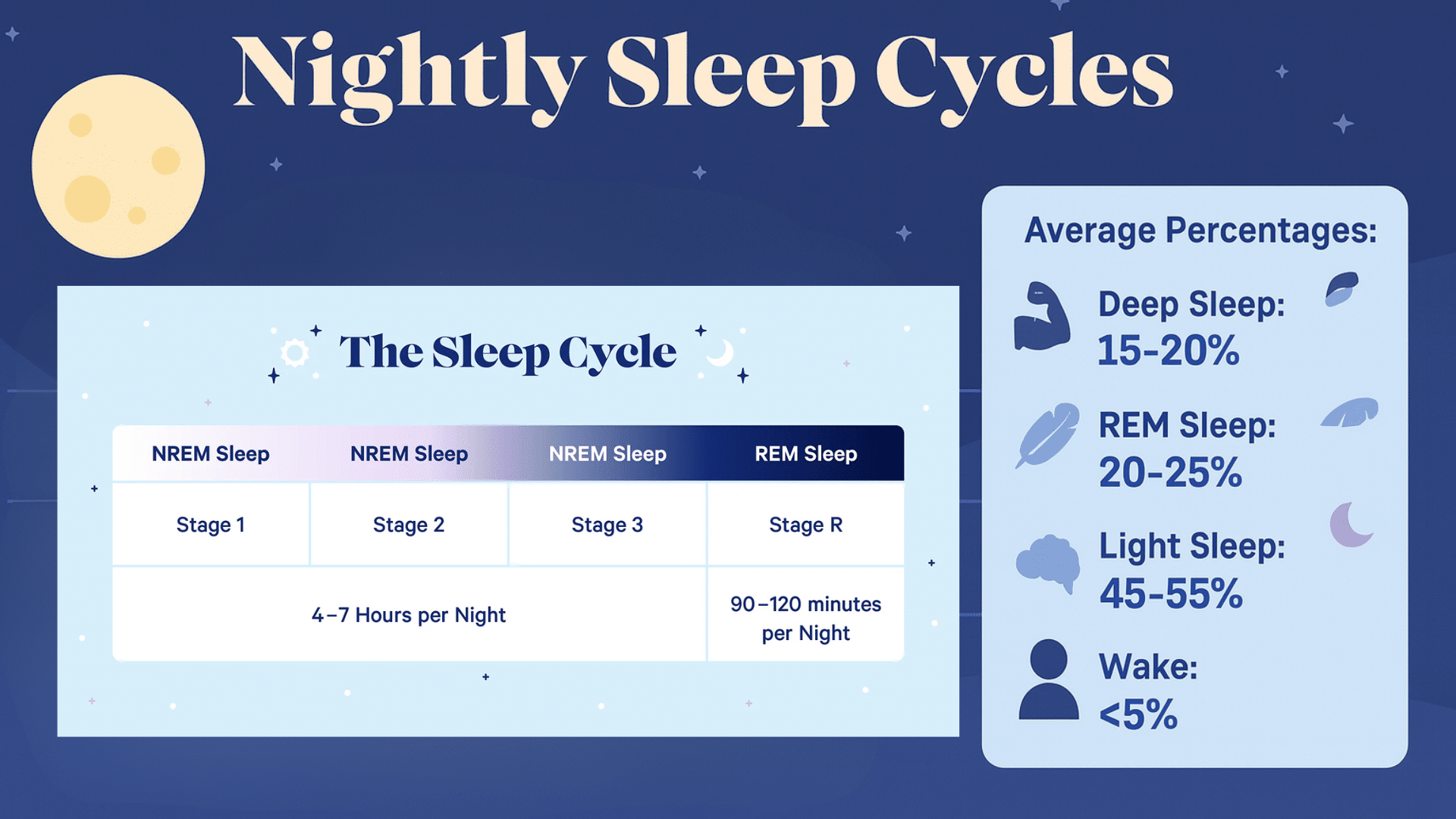
Understanding all sleep stages helps you see why core sleep is so important for feeling rested and healthy.
| Sleep Stage | Duration | Function | How You Feel |
|---|---|---|---|
| Light Sleep | 45-55% of the night | Transition between wake and deeper stages | Easy to wake up, not very restorative |
| Deep Sleep | 15-20% of the night | Physical recovery, immune function, and memory consolidation | Very hard to wake up, highly restorative |
| REM Sleep | 20-25% of the night | Emotional processing, creativity, and brain development | Vivid dreams, mental restoration |
| Awake Time | 5% or less | Brief awakenings (usually not remembered) | Normal part of the sleep cycle |
Core sleep represents the “sweet spot” for restoration because it includes both deep and REM stages. Light sleep serves as a bridge between wake and sleep states but doesn’t provide the same restorative benefits.
How Much Core Sleep Do You Need and Why?
Most healthy adults need 3-5 hours of core sleep per night, which typically represents 60-85% of their total sleep time. This breaks down to roughly 1-2 hours of deep sleep and 2-3 hours of REM sleep during a full night’s rest.
Age affects core sleep needs significantly. Teenagers and young adults often get more deep sleep as their bodies grow and develop.
Older adults typically experience less deep sleep and more fragmented REM sleep, which is why they may feel less rested despite spending adequate time in bed.
Signs you’re not getting enough core sleep include waking up tired despite adequate sleep hours, difficulty concentrating during the day, frequent afternoon energy crashes, getting sick more often, and feeling emotionally reactive or stressed.
Your sleep tracker showing consistently low core sleep percentages also indicates potential issues.
Factors That Affect Core Sleep Quality
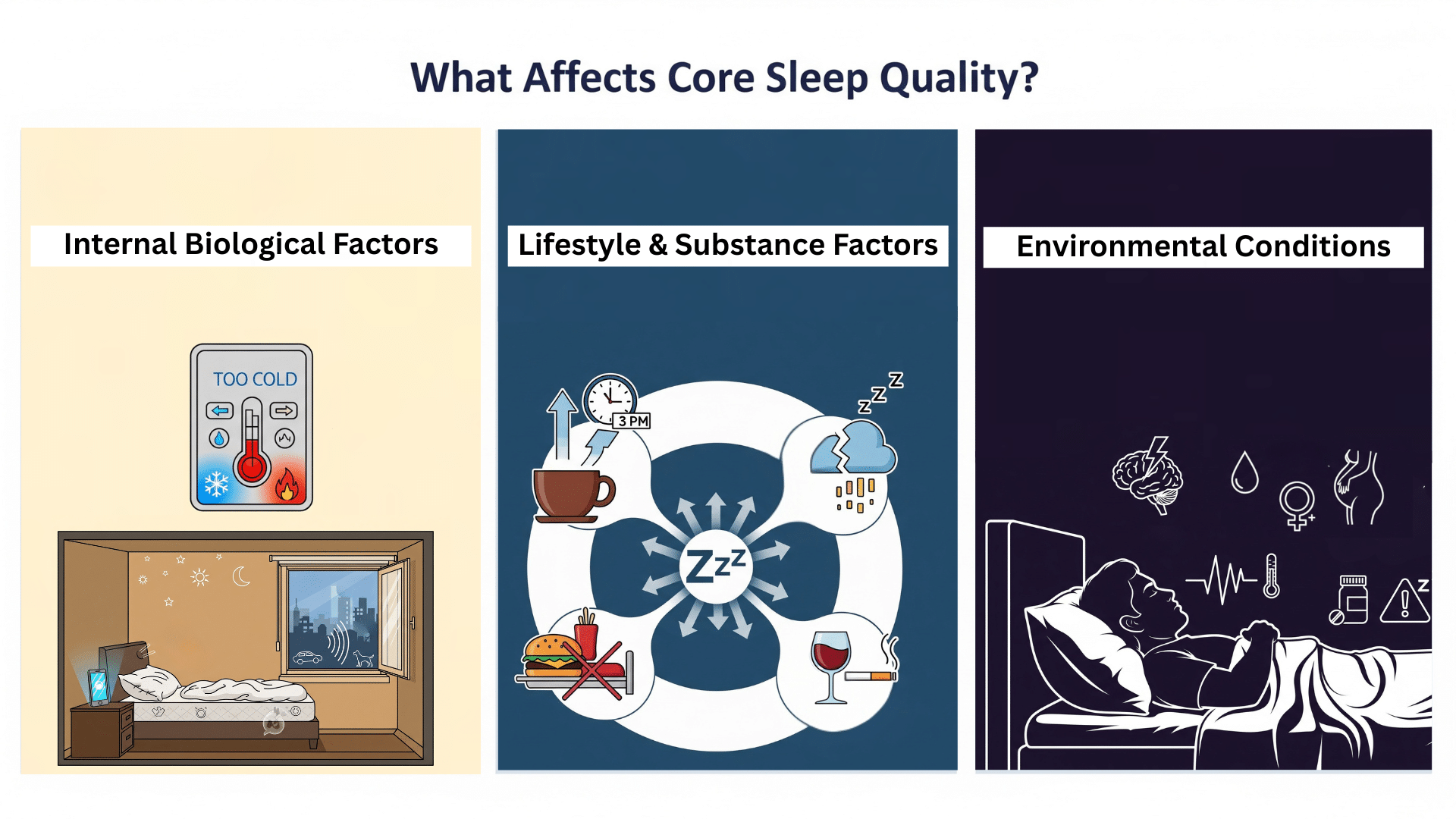
Many different factors influence how much core sleep you get each night, often in ways you might not expect.
1. Internal Biological Factors
Your age, stress levels, hormones, and overall health directly impact your ability to reach deep and REM sleep stages.
Chronic stress releases cortisol that can suppress deep sleep stages and make it harder to stay asleep.
Hormonal changes during menstruation, pregnancy, or menopause often disrupt REM sleep patterns and reduce overall sleep quality.
Illness and certain medications also reduce core sleep quality by interfering with your natural sleep architecture.
2. Lifestyle and Substance Factors
What you consume and when you consume it play a major role in core sleep quality throughout the night.
Caffeine consumed within 8 hours of bedtime can block deep sleep stages and reduce total restorative sleep time.
Alcohol initially makes you drowsy but disrupts REM sleep later in the night, leading to fragmented rest. Large meals, nicotine, and certain medications can also interfere with your body’s ability to reach deeper sleep stages.
3. Environmental Sleep Conditions
Your bedroom environment significantly impacts your ability to achieve and maintain core sleep throughout the night.
Rooms that are too warm (above 70°F) or too cold (below 60°F) can prevent your body from reaching deep sleep stages.
Noise pollution, light exposure, and uncomfortable mattresses or pillows also reduce time spent in restorative sleep stages.
Tips to Improve Your Core Sleep
Small changes to your daily routine and sleep environment can significantly increase your core sleep duration and quality.
- Sleep schedule consistency – Go to bed and wake up at the same time every day, even on weekends, to regulate your natural sleep-wake cycle.
- Bedtime routine preparation – Start winding down 1-2 hours before bed with calming activities like reading, gentle stretching, or meditation.
- Bedroom optimization – Keep your room between 60-67°F, as dark as possible, and as quiet as you can manage with blackout curtains or white noise machines.
- Substance timing – Stop caffeine intake after 2 PM, limit alcohol consumption, and avoid large meals within 3 hours of bedtime.
- Screen management – Turn off electronic devices at least 1 hour before bed, or use blue light filtering glasses to protect melatonin production.
Using Sleep Trackers to Understand and Improve Core Sleep
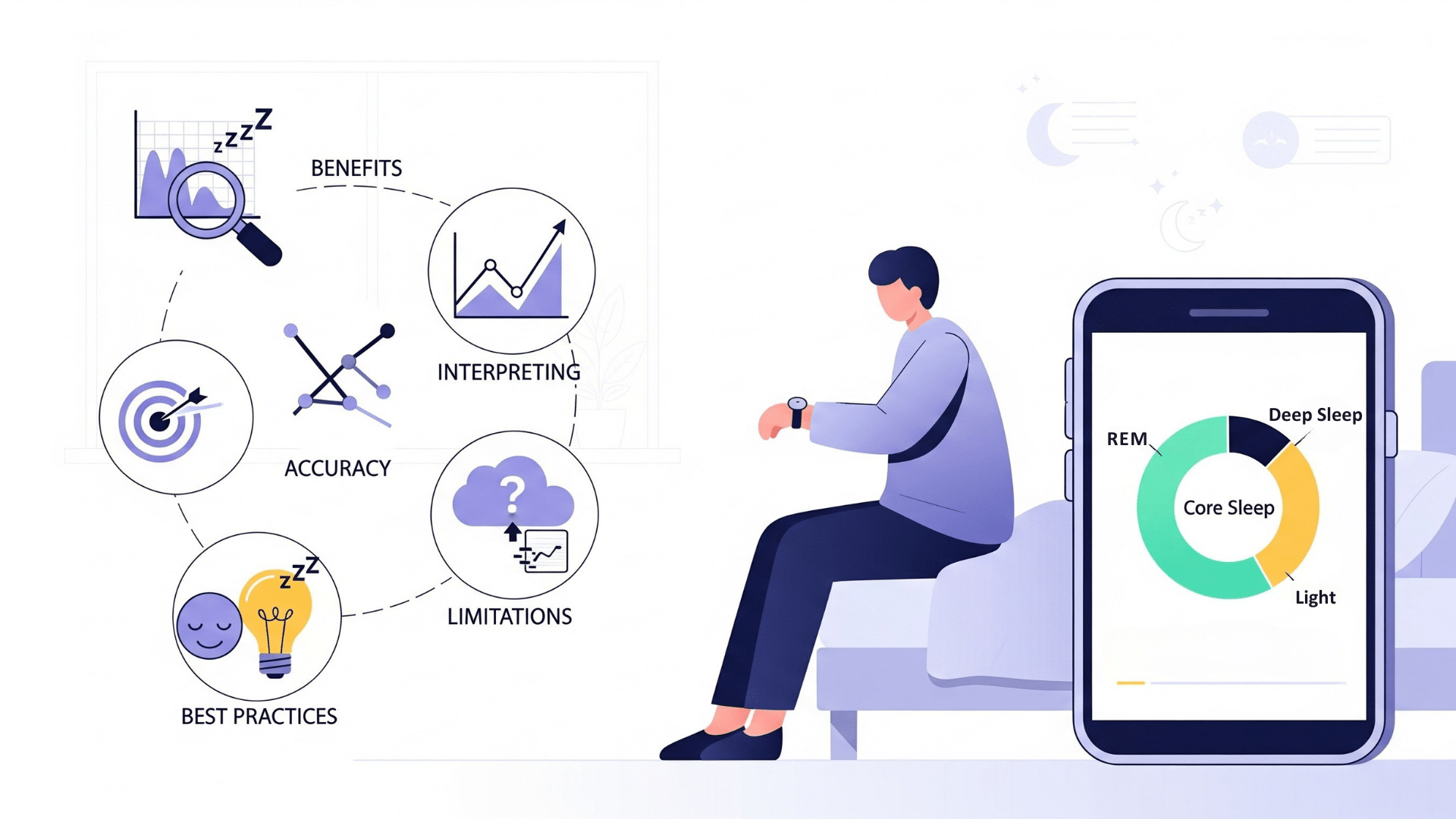
Sleep tracking devices provide valuable insights into your core sleep patterns, but understanding how to use this data effectively makes the biggest difference.
Here’s what you need to know about the benefits, interpretation methods, and limitations of popular sleep tracking technology.
| Aspect | What You Need to Know |
|---|---|
| Benefits of Tracking | Identify patterns in sleep quality, see how lifestyle changes affect core sleep, and catch potential sleep disorders early |
| Interpreting Reports | Look for trends over weeks rather than single nights; consistent low core sleep percentages (below 60%) may indicate issues |
| Device Accuracy | Wearables provide estimates, not medical-grade measurements; accuracy varies between brands and individuals |
| Data Limitations | Movement during sleep affects readings, and devices sometimes misidentify sleep stages or miss brief awakenings |
| Best Practices | Use data as a helpful guide rather than absolute truth, and pay attention to how you actually feel each morning |
Remember that sleep trackers are tools to help you understand your patterns, not perfect medical devices.
Conclusion
Core sleep represents the most vital portion of your nightly rest, combining deep sleep and REM sleep stages that restore your body and mind.
The combination of consistent sleep schedules, optimized bedroom environments, and mindful daily habits creates the foundation for quality core sleep.
Modern sleep trackers offer valuable insights into your sleep patterns, helping you see the connection between your lifestyle choices and sleep quality.
Monitor how these changes affect both your sleep tracker data and, more importantly, how you feel during the day.
What aspect of your sleep routine will you focus on improving first? Share your core sleep goals or questions in the comments below!
Frequently Asked Questions
What Exactly Is Core Sleep?
Core sleep is the combination of deep sleep and REM sleep stages, representing the most restorative portion of your nightly rest cycle.
How Do Popular Wearables Calculate Core Sleep?
Devices like Apple Watch and Fitbit use heart rate, movement, and breathing patterns to estimate when you’re in deep or REM sleep stages.
How Can I Increase My Core Sleep Duration?
Maintain consistent sleep schedules, optimize your bedroom environment, limit caffeine and screens before bed, and manage stress levels effectively.

